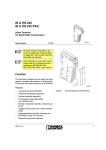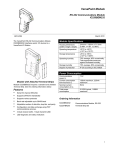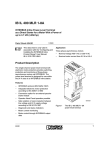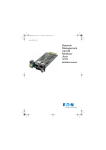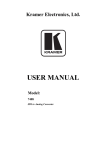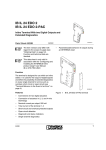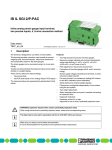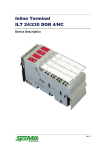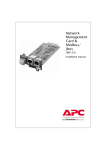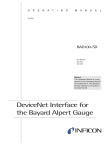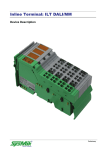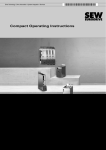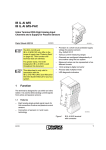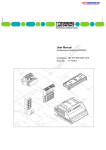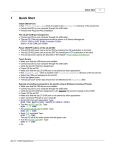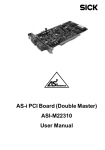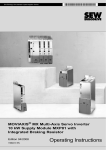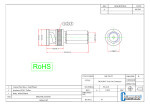Download Data Sheet DB EN IB IL RS 485/422-PRO - Digi-Key
Transcript
IB IL RS 485/422-PRO ... Inline terminal for serial data transmission 2 x AUTOMATION Data Sheet 6985_en_05 1 © PHOENIX CONTACT - 03/2008 Description The terminal is designed for use within an Inline station. It is used to operate standard I/O devices with serial interfaces on a bus system. Difference between IB IL RS 485/422 ... and IB IL RS 485/422-PRO ...: IB IL RS 485/422 ... Parameterization and data exchange are carried out via the bus using PCP services. Features – – – – – – A serial I/O channel (RS-485 or RS-422) Various protocols supported Transmission speed can be set up to 38400 baud Number of data bits, stop bits, and parity can be set 4 kbyte receive buffer and 1 kbyte transmit buffer Parameterization and data exchange via the bus using process data IB IL RS 485/422-PRO ... Parameterization and data exchange are carried out via the bus using process data. This allows faster communication times than with the IB IL RS 485/422. This data sheet is only valid in association with the IL SYS PRO INST UM E user manual. Make sure you always use the latest documentation. It can be downloaded at www.download.phoenixcontact.com. A conversion table is available on the Internet at www.download.phoenixcontact.com/general/7000_en_00.pdf. This data sheet is valid for the products listed on the following page: IB IL RS 485/422-PRO ... 2 Ordering data Products Description Type Order No. Pcs./Pkt. Inline terminal for serial data transmission, complete with accessories (connector and labeling fields); transmission speed 500 kbaud IB IL RS 485/422-PRO-PAC 2863627 1 Inline terminal for serial data transmission, without accessories, transmission speed 500 kbaud IB IL RS 485/422-PRO 2863707 1 Inline terminal for serial data transmission, complete with accessories (connector and labeling fields); transmission speed 2 Mbaud IB IL RS 485/422-PRO-2MBD-PAC 2878887 1 The listed connector set is needed for the complete fitting of the IB IL RS 485/422-PRO terminal. When using the terminal according to the example "RS-485: Terminal in the network center" on page 9 two shield connectors are required for connecting the cables. Accessories Description Type Order No. Connector set with a standard connector and a shield connector IB IL AO/CNT-PLSET 2732664 1 set Shield connector IB IL SCN-6 SHIELD 2736353 5 Documentation Description Type Order No. Pcs./Pkt. "Automation Terminals of the Inline Product Range" user manual IL SYS INST UM E 2698737 1 "INTERBUS Addressing" data sheet DB GB IBS SYS ADDRESS 9000990 1 3 Pcs./Pkt. Technical data General data Housing dimensions (width x height x depth) 24.4 mm x 136 mm x 72 mm (with connectors) Weight 90 g (without connectors), 135 g (with connectors) Operating mode Process data mode with 6 words Connection method for sensors 2 and 3-wire technology Permissible temperature (operation) -25°C to +55°C Permissible temperature (storage/transport) -25°C to +85°C Permissible humidity (operation/storage/transport) 10% to 95% according to DIN EN 61131-2 Permissible air pressure (operation/storage/transport) 70 kPa to 106 kPa (up to 3000 m above sea level) Degree of protection IP20 according to IEC 60529 Class of protection Class 3 according to EN 61131-2, IEC 61131-2 Connection data for connectors Connection type Spring-cage terminals Conductor cross-section 0.2 mm2 to 1.5 mm2 (solid or stranded), 24 - 16 AWG 6985_en_05 PHOENIX CONTACT 2 IB IL RS 485/422-PRO ... Interfaces Bus Local bus Through data routing Serial interfaces Type RS-485 half duplex or RS-422 full duplex Cannot be operated simultaneously Electrical data according to EIA (RS) 485, EIA (RS) 422, CCITT V.11 Line termination resistance 120 Ω typical Permissible input differential voltage ±5.7 V maximum Owing to the 120 Ω termination resistance the input differential voltage is limited to ±5.7 V. Hysteresis 50 mV, typical Input sensitivity -0.2 V minimum, +0.2 V maximum Output differential voltage (with 100 Ω load) ±2.0 V minimum Output differential voltage (with 54 Ω load) ±1.5 V minimum Short-circuit output current ±80 mA, typical Transmission speed IB IL RS 485/422-PRO 500 kbaud IB IL RS 485/422-PRO-PAC 500 kbaud IB IL RS 485/422-PRO-2MBD-PAC 2 Mbaud Supply of the module electronics through the bus coupler Connection method Potential routing Power consumption 500 kbps Communications power UL 7.5 V 7.5 V Current consumption at UL 170 mA, typical, 260 mA, maximum* 185 mA, typical, 260 mA, maximum* Total power consumption Approx. 1.275 W, typical, 1.950 W, maximum* Approx. 1.388 W, typical, 1.950 W, maximum* 2 Mbps * All connections of the serial interface are short-circuited. ATTENTION: Defective module when continuously short-circuited A continuous short circuit can damage the device. Therefore rule out continuous short circuits. This terminal takes no current from the UM and US potential jumpers. Power dissipation Power dissipation in the module PEL = 1.4 W Power dissipation of the housing PHOU 1.4 W, maximum (within the permissible operating temperature) Limitation of simultaneity, derating TA ≤ 50°C No derating TA > 50°C IQ = 4 A IQ: Total diagonal routing current IM/IS/GND Safety equipment None 6985_en_05 PHOENIX CONTACT 3 IB IL RS 485/422-PRO ... Electrical isolation/isolation of the voltage areas Electrical isolation of the logic level from the serial interface is ensured by the DC/DC converter. Common potentials The serial interface control and data lines have the same potential. FE is a separate potential area. Separate potentials in the system consisting of bus coupler/power terminal and I/O terminal Test distance Test voltage 5 V supply incoming remote bus / 7.5 V supply (bus logic) 500 V AC, 50 Hz, 1 min 5 V supply outgoing remote bus / 7.5 V supply (bus logic) 500 V AC, 50 Hz, 1 min RS-485/422 interface / 7.5 V supply (bus logic) 500 V AC, 50 Hz, 1 min RS-485/422 interface / 24 V supply (I/O) 500 V AC, 50 Hz, 1 min RS-485/422 interface / functional earth ground 500 V AC, 50 Hz, 1 min 7.5 V supply (bus logic) / 24 V supply (I/O) 500 V AC, 50 Hz, 1 min 7.5 V supply (bus logic) / functional earth ground 500 V AC, 50 Hz, 1 min 24 V supply (I/O) / functional earth ground 500 V AC, 50 Hz, 1 min Error messages to the higher-level control or computer system None Approvals For the latest approvals, please visit www.download.phoenixcontact.com or www.eshop.phoenixcontact.com. 4 Diagnostic/status indicators and terminal point assignment D T R R x D T x D 4.1 Local diagnostic and status indicators Des. Color D Green TR – Serial interface: RxD Yellow R S 4 8 5 /4 2 2 TxD 4.2 Meaning Diagnostics – Terminal is receiving data from the connected device Yellow Terminal is transmitting data to the connected device Function identification Orange 2 Mbps: white stripe in the vicinity of the D LED 2 1 1 2 1 .1 1 1 2 .1 1 .2 2 2 2 .2 1 .3 3 3 2 .3 1 .4 4 4 2 .4 6 1 9 9 A 0 0 3 Figure 1 6985_en_05 Diagnostic/status indicators and terminal point assignment PHOENIX CONTACT 4 IB IL RS 485/422-PRO ... 4.3 Terminal point assignment in the half-duplex operating mode (RS-485) Connec- Terminal Signal Assignment tor point 1 1.4, 2.4 FE Functional earth ground 2.3 GND GND* All other terminal points of this connector are not used. 2 1.1 TxD+ Reserved 2.1 TxD- Reserved 1.2 RxD+ Receive/transmit data (positive) 2.2 RxD- Receive/transmit data (negative) 1.3 R+ Termination resistor (positive) 2.3 RTermination resistor (negative) 1.4, 2.4 Shield Shield connection * Data direction Input/ output Input/ output For the IB IL RS 485/422-PRO (-PAC) terminal, hardware version 01 or later. In all previous versions terminal point 2.3 is not used. For the IB IL RS 485/422-PRO-2MBD-PAC terminal, hardware version 00 or later. 4.4 Terminal point assignment in the full-duplex operating mode (RS-422) Connec- Terminal Signal Assignment tor point 1 1.4, 2.4 FE Functional earth ground 2.3 GND GND* All other terminal points of this connector are not used. 2 1.1 TxD+ Transmit data (positive) 2.1 TxD- Transmit data (negative) 1.2 2.2 1.3 2.3 1.4, 2.4 * Data direction Output Output RxD+ Receive data Input (positive) RxD- Receive data Input (negative) R+ Termination resistor (positive) RTermination resistor (negative) Shield Shield connection For the IB IL RS 485/422-PRO (-PAC) terminal, hardware version 01 or later. In all previous versions terminal point 2.3 is not used. For the IB IL RS 485/422-PRO-2MBD-PAC terminal, hardware version 00 or later. Observe the connection notes on page 7. 6985_en_05 PHOENIX CONTACT 5 IB IL RS 485/422-PRO ... 5 Internal circuit diagram L o c a l b u s U U U O P C D L + A N A L - 2 4 V R x D 5 V T R T x D 5 V 5 V 1 µ P R S -4 8 5 /4 2 2 In te rfa c e / / T x D + + 2 4 V (U S ) 1 T x D - R x D + R x D - R + R - + 2 4 V (U M ) G N D 6 1 9 9 C 0 0 4 Figure 2 Internal wiring of the terminal points Key: Protocol chip (bus logic including voltage conditioning) OPC x x x R S -4 8 5 /4 2 2 In te rfa c e / µ P RS-485/422 interface Diagnostic and status indicators with function information Capacitor Optocoupler Resistor DC/DC converter with electrical isolation X X X / 1 Ground, electrically isolated from ground of the communications power UL Microprocessor Hardware version 01 or later: GND is assigned to terminal point 2.3 of the IB IL RS 485/ 422-PRO (-PAC) terminal. In all previous versions, this terminal point is not used. For the IB IL RS 485/422-PRO-2MBD-PAC terminal with hardware version 00 or later, the terminal point 2.3 is assigned to GND. 6985_en_05 Other symbols used are explained in the IL SYS INST UM E user manual or in the Inline system manual for your bus system. PHOENIX CONTACT 6 IB IL RS 485/422-PRO ... 6 Serial interface 7 Connection notes The terminal has an RS-485 and an RS-422 interface. The interfaces can only be operated alternatively. 6.1 By assigning terminal points 1.4 and 2.4 of both connectors you can connect the cable shield either using a capacitor (connector 2) or directly (connector 1) to functional earth ground (FE). RS-485 In RS-485 operating mode, an RS-485 network with several devices can be created. The two connection options allow to connect one cable shield side to FE directly and the other capacitively - without additional effort. In this way, you can prevent ground loops occurring if a shield is connected directly to FE on both sides. Use a data cable with commonly shielded twisted pairs to connect the devices. Equip this data cable with a termination resistor at both most remote points of the RS485 network. To connect them to the Inline terminal, use the termination resistor installed in the device (see Figure 2). No matter at what side you connect the shield, you must connect all wires to connector 2. Connection examples are shown in Figures 5 to 7 on pages 9 to 10. Use at least one connector with shield connection when connecting the I/O device. This operating mode supports the half-duplex transmission. Make sure that only one device is transmitting data at a time. In order to be able to guarantee a defined cable idle state, the data cable polarization is contained in the terminal. 6.2 7.1 Shield connected capacitively to FE RS-422 In RS-422 operating mode, it is possible to establish a pointto-point connection. Use a data cable with commonly shielded twisted pairs to connect the devices. Equip this data cable with a termination resistor at each device. To connect them to the Inline terminal, use the termination resistor installed in the device (see Figure 2). 6 8 7 8 B 0 0 5 Connection examples are shown in Figures 8 to 9 on pages 10 to 11. Figure 3 This operating mode supports full-duplex transmission. 7.2 Position of the shield connector to connect the shield capacitively to FE Shield connected directly to FE 6 8 7 8 B 0 0 6 Figure 4 6985_en_05 Position of the shield connector to connect the shield directly to FE PHOENIX CONTACT 7 IB IL RS 485/422-PRO ... 8 Connection examples 8.1 Comparison of the connection examples in Figure 5 to Figure 9 Operating mode Special remark Shield connection Comment RS-485 IB IL RS 485/422-PRO terminal as network end point IB IL RS 485/422-PRO in the network center IB IL RS 485/422-PRO terminal as network end point Shield connected capacitively to FE Shield connected directly Capacitive Termination resistor required – RS-485 RS-485 RS-422 RS-422 Capacitive/ direct Direct Capacitive Direct Termination resistor required Termination resistor required Termination resistor required Required connectors Example per in IB IL RS 485/422-PRO Connector set Figure 5 2 shield connectors Figure 6 Connector set Figure 7 Connector set Figure 8 Connector set Figure 9 The connector set consists of a shield connector and a standard connector. For connection, please observe the following notes: – – – Always connect the shield between two devices on one side using a capacitor and on the other side directly to FE. An RS-485 network must be equipped with termination resistors at both ends. For an RS-422 point-to-point connection, the receive signals on every device must be fitted with termination resistors. 6985_en_05 PHOENIX CONTACT 8 IB IL RS 485/422-PRO ... 8.2 RS-485: Terminal as network end point Connect the shield to FE using a capacitor. Connector 1 2 IB IL RS 485/422-PRO ... TxD+ 1.1 TxD- 2.1 D TR RxD TxD RS485/422 1 2 1 2 1 11 1 2 22 2 3 33 3 4 44 4 RxD+ 1.2 Transmit/receive data (positive) RxD- 2.2 Transmit/receive data (negative) R+ 1.3 R- 2.3 Termination resistor connection via R+ and R- Inline connector (connector 2) RS 485 RS 485 RS 485 6199B008 Figure 5 8.3 RS-485 interface wiring: IB IL RS 485/422-PRO ... as the end point of a network, data line shield connected to FE using a capacitor RS-485: Terminal in the network center 1 Connector 2 IB IL RS 485/422-PRO ... TxD+ 1.1 RxD TxD RS 485 RS 485 RxD+ 1.2 RxD- 2.2 RS485/422 1 Transmit/ receive data (positive) Transmit/ receive data (negative) TxD- 2.1 D TR 2 1 2 1 11 1 2 22 2 3 33 3 4 44 4 R+ 1.3 R- 2.3 Inline connector (connector 2) RS 485 RS 485 RS 485 6199B009 Figure 6 6985_en_05 RS-485 interface wiring: IB IL RS 485/422-PRO ... in the center of a network, data line shield directly and connected capacitively to FE PHOENIX CONTACT 9 IB IL RS 485/422-PRO ... 8.4 RS-485: Terminal as network end point Connect the shield directly to FE. Connector 1 2 IB IL RS 485/422-PRO ... TxD+ 1.1 TxD- 2.1 Transmit/receive data (positive) RxD+ 1.2 Tranmit/receive data (negative) RxD- 2.2 Termination resistor connection via R+ and R- R+ 1.3 R- 2.3 Inline connector (connector 2) RS 485 RS 485 D TR RxD TxD RS485/422 1 2 1 2 1 11 1 2 22 2 3 33 3 4 44 4 6199B010 Figure 7 8.5 RS-422: Shield connected capacitively to the terminal Connector 1 2 D TR RxD TxD RS485/422 1 RS-485 interface wiring: IB IL RS 485/422-PRO ... as the end point of a network, data line shield connected directly to FE 2 1 2 1 11 1 2 22 2 3 33 3 4 44 4 IB IL RS 485/422-PRO ... RS-422 device TxD+ 1.1 Transmit data (positive) Receive data (positive) TxD- 2.1 Transmit data (negative) Receive data (negative) RxD+ 1.2 Receive data (positive) Transmit data (positive) RxD- 2.2 Receive data (negative) Transmit data (negative) R+ 1.3 R- 2.3 Inline connector (connector 2) Termination resistor connection via R+ and R- Termination resistor connection RS 422 6199C011 Figure 8 6985_en_05 RS-422 interface wiring: Data line shield connected capacitively to FE PHOENIX CONTACT 10 IB IL RS 485/422-PRO ... 8.6 RS-422: Shield directly connected to the terminal Connector 1 2 IB IL RS 485/422-PRO ... TxD+ 1.1 RxD TxD RS485/422 1 Transmit data (positive) Receive data (positive) Transmit data (negative) Receive data (negative) RxD+ 1.2 Receive data (positive) Transmit data (positive) RxD- 2.2 Receive data (negative) Transmit data (negative) TxD- D TR 2 1 2 1 11 1 2 22 2 3 33 3 4 44 4 RS-422 device 2.1 R+ 1.3 R- 2.3 Inline connector (connector 2) Termination resistor connection via R+ and R- Termination resistor connection RS 422 6199C012 Figure 9 RS-422 interface wiring: Data line shield directly connected to FE 9 Programming data/configuration data 9.1 Local bus (INTERBUS) ID code Length code Process data channel Input address area Output address area Parameter channel (PCP) Register length (bus) 9.2 BFhex (191dec) 06hex 96 bits 12 bytes 12 bytes 0 bytes 12 bytes Other bus systems For the programming data/configuration data of other bus systems, please refer to the corresponding electronic device data sheet (e.g., GSD, EDS). 6985_en_05 PHOENIX CONTACT 11 IB IL RS 485/422-PRO ... 10 Data storage and transmission The terminal stores the received serial data in an intermediate buffer until it is fetched from the serial interface by the bus controller board or the device. Serial data traffic can be managed using various protocols. The protocol used depends on the type of protocol supported by the peers. 10.1 Overview of supported protocols Protocol Receive buffer Transmit memory Transpar- 4096 bytes ent End-to25 buffers end with 11 bytes each Dual 2 buffers with buffer 11 bytes each 1023 bytes Special features when receiving Two end characters are filtered out Only stores the most recently received data, end characters are filtered out 5 buffers with Data exchange 25 buffers with 11 bytes 330 bytes with software handshake, each each time monitoring, and checksum 4096 bytes 1023 bytes Software handshake 11 bytes 11 bytes Data exchange with time monitoring and check sum 3964R XON/ XOFF Movilink 1023 bytes (including end characters) 1023 bytes (including end characters) The Movilink protocol is available for firmware Version 1.10 or later. 10.2 Transparent protocol If the transparent protocol is used, serial data is transmitted through the terminal in the same format it was received from the serial interface or the bus side. 10.3 End-to-end protocol The serial data is conditioned for the end-to-end protocol. If serial data is sent from the bus side, two additional characters, the first and second delimiters, are attached for transmission to the serial interface. The first and second delimiters are defined upon terminal configuration. Serial data sent from the serial interface can only be read by the user if the terminal has received the first and second delimiters. Both delimiters confirm that the serial data has been received without error and the maximum data length of 11 bytes has been observed. The delimiters are filtered out when the data is read by the bus side. Unlike in the transparent protocol, the receive memory is not organized as a FIFO but as a buffer. 25 buffers with 11 bytes each are available. If the buffer size of 11 bytes is exceeded, without the two delimiters being detected, the buffer is overwritten again. The transmit FIFO consists of 1023 bytes. The delimiters are attached to, and stored with, the data to be sent. 10.4 Dual buffer protocol With this protocol, the last received data block is stored. A data block is defined as a sequence of characters with the first and second delimiter end characters, as in the end-toend protocol. As soon as a new data block is received, the previous one is overwritten. This is achieved by means of two buffers, which are written alternately. In this way, there is always one buffer ready to receive serial data while the second buffer stores the most recently received data block. A data block is only regarded as complete once both delimiters have been detected, one after the other. It can then be read from the bus side. If the buffer size of 11 bytes is exceeded, without the two delimiters being detected, the buffer is overwritten again. When transmitting serial data, the same is valid as for the end-to-end protocol: If serial data is sent from the bus side, two additional characters, the first and second delimiters, are attached for transmission to the serial interface. The transmit FIFO (First-In-First-Out memory) can store 1023 bytes (1 kbyte) and the receive FIFO can store 4096 bytes (4 kbytes). If the terminal receives another character after the 4095th character, the error pattern is stored in the receive FIFO. All further characters are ignored. 6985_en_05 PHOENIX CONTACT 12 IB IL RS 485/422-PRO ... 10.5 3964R protocol 10.6 This protocol, developed by Siemens, is the most complex. It uses start and end identification, checksum and time monitoring. 5 buffers are available for transmitting, 25 buffers are available for receiving. Character delay time: Acknowledgment delay time: Block waiting time: Number of attempts to establish a connection: 220 ms 2s 10 s 6 The optional 3964 priority defines which device may send first (high priority) if there is an initialization conflict (several devices attempting to send data simultaneously). As the RS-485 interface is a half duplex interface a waiting time (slave response time) is kept between data transmission and reception. It is 11 bits and depends on the baud rate. XON/XOFF protocol This protocol operates like the transparent protocol, however, using a software handshake. Data transmission with this protocol is controlled by the XON and XOFF characters. XON is set to 11hex and XOFF to 13hex. If the terminal receives an XOFF, no more serial data will be sent until an XON is received. The terminal itself will transmit an XOFF if the available space in the receive memory is less than 5 bytes. As soon as more memory becomes available again, the module will transmit a single XON. Transmission of serial data is not filtered. Any characters, which occur with the code defined for XON and XOFF, are thus transmitted and may trigger undesirable events at the receiver. When serial data is received, the XON and XOFF characters are filtered and are not available as data. Any characters with the XON or XOFF code are lost. Ensure that characters with these codes do not appear in the data stream. With the XON/XOFF protocol this function is only completely available for the RS-422 interface. It can be discussed if using the protocol for the RS-485 interface is useful as the latter is a half duplex connection, which enables either to transmit or to receive data. However, with the XON/XOFF protocol the receiver can respond with a XOFF at any time when transmitting characters. Reception of this control character by the transmitter is thus not ensured. 10.7 Movilink protocol The terminal is the Movilink master in the Movilink protocol. After transmission of a telegram the terminal waits for a maximum of 500 ms for the response. After the response was received, the response data is available in the input data. Only then can the next telegram be sent. A delimiter is placed ahead of the process data when a Movilink telegram is being sent. The calculated checksum is added behind the process data. When the data is received, the delimiter and the checksum are filtered out before the data is transmitted over the bus. Transmit or receive errors are reported when a transmission timeout or a negative checksum comparison occurs. Transmit and receive buffer have a size of 11 bytes each. 6985_en_05 PHOENIX CONTACT 13 IB IL RS 485/422-PRO ... 11 11.1 Process data The terminal process image comprises six data words each in input and output direction. For the assignment of the illustrated (word.bit) or (byte.bit) view to your INTERBUS control system or computer system, please refer to the DB GB IBS SYS ADDRESS data sheet. 4 3 x x 2 1 0 x x x 15 14 13 12 11 10 9 8 7 6 5 Command IN parameter x x x 4 3 x x 2 1 0 x x x Status word Err: error x = 0 or 1; the assignment depends on the command. 0 3 2 5 4 7 6 9 8 11 10 000 Data Data Data Data Data Data Data 1 Data Code (Bin) Data 9 10 11 Data 8 Data 7 Data 6 Data 5 Data 4 Data 3 Data 2 Data 1 Data 5 Data 4 Data 3 Data 2 7 6 5 x x x 0 Status Command/ parameter parameter OUT IN 1 15 14 13 12 11 10 9 8 OUT 0 Command parameter Data 0 Control word Err The terminal has six process data words. Word Byte in the Motorola format Byte in the Intel format Word 0 general The byte representation in the Motorola format, also called Big Endian (high order byte at starting address) corresponds to the INTERBUS standard representation. All byte representations in the data sheet have this format. The byte representation in the Intel format is also called Little Endian (low order byte at starting address). The command is used to determine the function. The actually transmitted data depends on the command. 001 010 011 100 101 110 111 Code Command (hex) (with bit 15 = 0) 0 Read status bits. Input word 1 contains the number of characters received. 1 Transmit characters 2 Buffer characters (not in the Movilink protocol) 3 Read characters. Parameter = Chex: Read FW version, Parameter = Dhex: Read configuration 4 Write configuration 5 Toggle command 1: transmit characters 6 Toggle command 2: Buffer characters (not in the Movilink protocol) 7 Toggle command 3: Read characters (not in the Movilink protocol) Command toggling Command toggling is used to execute a command on a terminal again. In this way a second command code is available for the same function. This applies for the following commands: – Transmit characters – Buffer characters (not in the Movilink protocol) – Read characters (not in the Movilink protocol) Here, bit 14 is used for toggling. 6985_en_05 PHOENIX CONTACT 14 IB IL RS 485/422-PRO ... 11.2 "Read Status Bits" command Control word MSB 15 LSB 14 13 12 0 0 0 11 10 9 8 7 6 5 4 3 2 1 0 Receive error 0: No action 1: Reset receive error Transmit error 0: No action 1: Reset transmit error Status word MSB 15 LSB 14 13 12 0 0 0 11 10 9 Number of received data 8 7 6 5 Reserved Transmit buffer 4 3 1 0 Reserved Receive buffer 0: Empty 1: Not empty 0: Empty 1: Not empty Transmit butter 0: Not full 1: Full Figure 10 2 Receive error 0: No error 1: Error Receive buffer Transmit error 0: Not full 1: Full 0: No error 1: Error 6985D001 Format of the process data word 0 In the Movilink protocol bits 8 to 11 in the status word have no meaning. Bit/status Bit 0 = '1' Bit 1 = '1' Bit 2 = '1' Bit 3 = '1' Bit 4 = '1' 6985_en_05 Effect The receive buffer is not empty, there are characters to be read. Protocol All excluding Movilink The receive error indicates that a 3964R telegram could not be received without error after six 3964R transmit attempts by the serial peer or after the block waiting time had elapsed. The receive error indicates that Movilink – a parity error occurred while the response was received, – the first character received is not SD2, – the checksum test was negative, – the number of received characters is unequal to the number of transmitted characters. The transmit error indicates that a 3964R telegram could not be transmitted from the module 3964R to the serial peer without error after six transmit attempts. The telegram was rejected. The transmit error indicates, that the set timeout of 500 ms elapsed and a response has not Movilink yet been received. Reserved The receive buffer is full: Transparent, end-to-end, Transparent and XON/XOFF protocol: Residual capacity: <15 3964R, XON/ characters XOFF 3964R and end-to-end protocol: Residual capacity: none PHOENIX CONTACT 15 IB IL RS 485/422-PRO ... Bit/status Bit 5 = '1' Bit 6 = '1' Bit 7 = '1' Bits 8 to 11 Effect The transmit buffer is full: 3964R protocol: Dual buffer, transparent, end-to-end, and XON/XOFF protocol: Residual capacity: none Residual capacity: ≤30 characters The transmit buffer is not empty, there are characters to be transmitted. The transmit buffer is not empty, there are characters to be transmitted. This bit is set during the entire data transmission. Reserved Number of characters received. If the code = Fhex, more than 14 characters have been received. Protocol All excluding Movilink All excluding Movilink Movilink All excluding Movilink With the "Read Status Bits" command the content of the input data is continuously updated. Unlike with other commands toggling is not required. Both error bits (bits 1 and 2) are not automatically reset. They can only be reset by the process data output word. In the transparent and XON/XOFF protocols, the input word 1 contains the total number of characters received. 6985_en_05 PHOENIX CONTACT 16 IB IL RS 485/422-PRO ... 11.3 "Transmit Characters" command Process data is stored in the transmit memory and then directly transmitted via RS-485 or RS-422. A maximum of eleven characters can be transmitted. The OUT parameter determines the number of characters to be transmitted. Characters stored in the intermediate buffer are transmitted first. After the command has been executed successfully the intermediate buffer is cleared. Process data assignment for the "Transmit Characters" command with eleven characters (C1 - C11) The start delimiter of the request telegram (SD1) and the response telegram (SD2) are defined as follows: SD1 = 02hex, SD2 = 1Dhex. The error bit (bit 15 in the status word, i.e. in the first word received (Wort 0)) indicates the acknowledgment: Error bit = 0: Data transmission is okay, the data behind byte 1 is response data of the Movilink peer. Reasons for an error bit set: – OUT parameter = 0 and intermediate buffer empty – OUT parameter >11 – Not enough space in the transmit memory – Not enough space in the intermediate buffer Error bit = 1: An error has occurred. It may have several causes: – The length information in the output data is equal to 0 or larger than 11. – The Movilink response is invalid; The options are as follows: – The first character is unequal SD2. – The checksum comparison is negative. – The number of received characters is unequal to the number of transmitted characters. – Parity errors occurred while the response was received. – The timeout period elapsed, which means that no response was received within 500 ms. "Transmit Characters" command for the Movilink protocol Set the toggle bit for the next transfer in the command. If command 1 was used before, command 5 will be sent. Then command 1 again. 0 Word Byte OUT IN 0 1 C 1Bhex 1 1Bhex – 1 2 C 2 – 2 3 C 3 – 4 C 4 – 3 5 C 5 – 6 C 6 – 4 7 C 7 – 8 C 8 – 5 9 C 9 – 10 C1 0 – 11 C1 1 – After the command 1hex or 5hex was received over the bus, the terminal generates a Movilink telegram. The process data length is specified in the first byte (in the example Ahex = 10 bytes). The SD1 start delimiter is placed ahead of the process data in the telegram. The calculated checksum is added behind the process data. The checksum is calculated over the complete telegram. Process data assignment for the "Transmit Characters" command with 10 characters (C1 - C10) Output data 5 0 3 Word 1 2 4 Byte 0 1 2 3 4 5 6 7 8 9 10 11 OUT 1Ahex C1 C2 C3 C4 C5 C6 C7 C8 C9C10 _ 11.4 "Store Characters Temporarily" command The transmit data is stored in an intermediate buffer, which can store 330 characters. No characters are transmitted. The OUT parameter determines the number of characters. The "Transmit Characters" command is used for transmitting the data stored temporarily. In this way character blocks of up to 330 characters can be transmitted. They are divided over 20 telegrams with 11 characters each. Reasons for an error bit set: – OUT parameter = 0 or >11 – Not enough space in the intermediate buffer 11.5 "Read Characters" command Movilink telegram Delimiter Address Type User data Checksum 6985A003 The command is only acknowledged over the bus, when either the response of the Movilink peer was received or the timeout period of 500 ms elapsed. When there is a positive acknowledgment (error bit = 0) the process input data contains the response data. Start delimiter and checksum have been filtered out from the response. This command is used to read a maximum of eleven characters. The IN parameter contains the number of valid characters available in the input data. Process data assignment for the "Read Characters" command with eleven characters (C1 - C11) Word Byte OUT IN 6985_en_05 0 0 1 30hex – C 3Bhex 1 1 2 – C 2 2 3 – C 3 4 – C 4 3 5 – C 5 6 – C 6 4 7 – C 7 8 – C 8 5 9 – C 9 10 – C1 0 PHOENIX CONTACT 11 – C1 1 17 IB IL RS 485/422-PRO ... 11.6 "Write Configuration" command Output type Process data assignment for the "Write Configuration" command Code Meaning Output words 0 to 5 0hex RS-485 1hex RS-422 Code Meaning 00hex Transparent 01hex End-to-end 02hex Dual buffer IN – – 5 6 4 7 8 5 9 10 11 – – – – – Reserved Reserved Protocol Reserved Baud rate/data width – 4 Direct baud rate 3 2nd delimiter 2 3 1st delimiter 1 Output type/protocol 2 0 40hex OUT 1 Error pattern 0 40hex Word Byte – – – 03hex 3964R with low priority 04hex 3964R with high priority 05hex XON/XOFF 06hex Movilink Output word 1 7 6 5 Byte 2 4 3 2 1 Protocol Output type: 0: RS 485 1: RS 422 Figure 11 0 7 6 5 Byte 3 4 3 2 Baud rate The Movilink protocol is available for firmware Version 1.10 or later. 1 0 Baud rate Data width 6985B002 Output word 1 in the "Write Configuration" command Element value range The options in bold are default settings. Error pattern Code Value 00hex 110 baud 01hex 300 baud 02hex 600 baud 03hex 1200 baud 04hex 1800 baud 05hex 2400 baud 06hex 4800 baud 07hex 9600 baud 08hex 19200 baud Meaning 09hex 38400 baud 24hex $ 0Dhex Directly, basis 500 kbaud xxhex Any character 0Ehex Directly, basis 62.5 kbaud 0Fhex Directly, basis 15625 baud Code The error pattern contains the character that is written into the FIFO, if a character was received with an error (not valid for the 3964R protocol). Reasons are e.g. parity errors, exceeded value range, superimposed noise. In the transparent and XON/XOFF protocols, the pattern is also used if the receive FIFO is full and further characters are received. 6985_en_05 The specified baud rates of 110 baud to 38400 baud are adequate for most applications. However, you can freely choose the baud rate by means of direct programming. For this, use the 0Dhex, 0E hex and 0Fhex baud rate codes in the output word 1, see "Direct Baud Rate (DBC)" on page 19. PHOENIX CONTACT 18 IB IL RS 485/422-PRO ... Data width Code Meaning 00hex Representation in CMD/PC WORX Data bits Parity Stop bits 7 even 1 7 data bits, even parity, 1 stop bit 01hex 7 odd 1 7 data bits, odd parity, 1 stop bit 02hex 8 even 1 8 data bits, even parity, 1 stop bit 03hex 8 odd 1 8 data bits, odd parity, 1 stop bit 04hex 8 None 1 8 data bits, without parity, 1 stop bit 05hex 7 None 1 7 data bits, without parity, 1 stop bit 06hex 7 even 2 7 data bits, even parity, 2 stop bits 07hex 7 odd 2 7 data bits, odd parity, 2 stop bits 08hex 8 even 2 8 data bits, even parity, 2 stop bits 09hex 8 odd 2 8 data bits, odd parity, 2 stop bits 0Ahex 8 None 2 8 data bits, without parity, 2 stop bits 0Bhex 7 None 2 7 data bits, without parity, 2 stop bits Direct Baud Rate (DBC) First delimiter Code Meaning 0Dhex Carriage Return (CR) xxhex Any character Choose direct programming of the baud rate in the output word 1 by means of the 0Dhex, 0Ehex and Fhex baud rate codes. You can select a basic clock for the baud rate. The actual baud rate is calculated according to the following formula: Second delimiter Baud rate = basic clock / (DBC + 1) Code Meaning 0Ahex Line Feed (LF) xxhex Any character Specify DBC in the output byte 6. To determine DBC change the equation to read: DBC = basic clock / baud rate - 1 The first delimiter and the second delimiter contain the end characters for the dual buffer and the end-to-end protocols. After successful configuration the characters for the receive and transmit FIFO are reset. In this way, all transmit and receive data that have not yet been processed will be deleted. Reasons for an error bit set: – Using a reserved code – Setting a reserved bit – Baud rate 110 baud or 300 baud in the 3964 protocol 6985_en_05 Example: The baud rate is 15625 baud. A basic baud rate of 500 kbaud (code 0Dhex) is chosen. Determine the direct baud rate: DBC = (500000 baud / 15625 baud) - 1 = 31dec = 1Fhex An example for the first four output words is: 40 00 00 D2 00 00 1F hex. Programming of the direct baud rate theoretically enables a maximum value of 500 kbaud. Proper operation of the terminal is tested and guaranteed for up to 38400 baud. Operation with higher baud rates depends on the application. PHOENIX CONTACT 19 IB IL RS 485/422-PRO ... Example for a configuration with transparent protocol 11.7 – – – – Process data assignment for the "Read Configuration" command – – – – – – – – Example for a configuration with Movilink protocol – – – – Default: Movilink protocol Baud rate: 9600 baud Data width: 8 data bits with odd parity and one stop bit Configuration (in hex): 4000 0672 0000 0000 11.8 x x x 00 00 10 11 00 x 00 5 9 x x Direct baud rate 8 00 x 2 nd delimiter 7 x IN 6 1st delimiter OUT 10 11 5 x Reserved – – 9 4 Baud rate/data width Direct baud rate OUT 40 00 00 83 00 00 00 IN 40 – – – – – – 8 3 4 x 7 2 3 Output type/protocol 6 1 2 x 5 0 1 Error pattern 4 0 3Dhex 3 Reserved 2 5 Reserved 1 Meaning 0 2nd delimiter 4 1st delimiter 3 Baud rate/data width 2 Output type/protocol 1 Error pattern 0 40hex Word Byte Word Byte 3Dhex Default: Transparent protocol Baud rate: 19200 baud Data width: 8 data bits with odd parity and one stop bit Configuration (in hex): 4000 0083 0000 0000 "Read Configuration" command "Read Firmware Version" command With a control word of 3C00hex, the second input word supplies the firmware version and the type code. 15 14 13 12 11 10 9 8 7 6 5 Firmware version, e.g.,100hex 4 3 2 1 0 Type code: 7hex Type code 7hex is identical with the type code of IB IL RS 485/422 .... 6985_en_05 PHOENIX CONTACT GmbH & Co. KG • 32823 Blomberg • Germany • Phone: +49-(0) 5235-3-00 PHOENIX CONTACT • P.O.Box 4100 • Harrisburg • PA 17111-0100 • USA • Phone: +717-944-1300 www.phoenixcontact.com 20





















